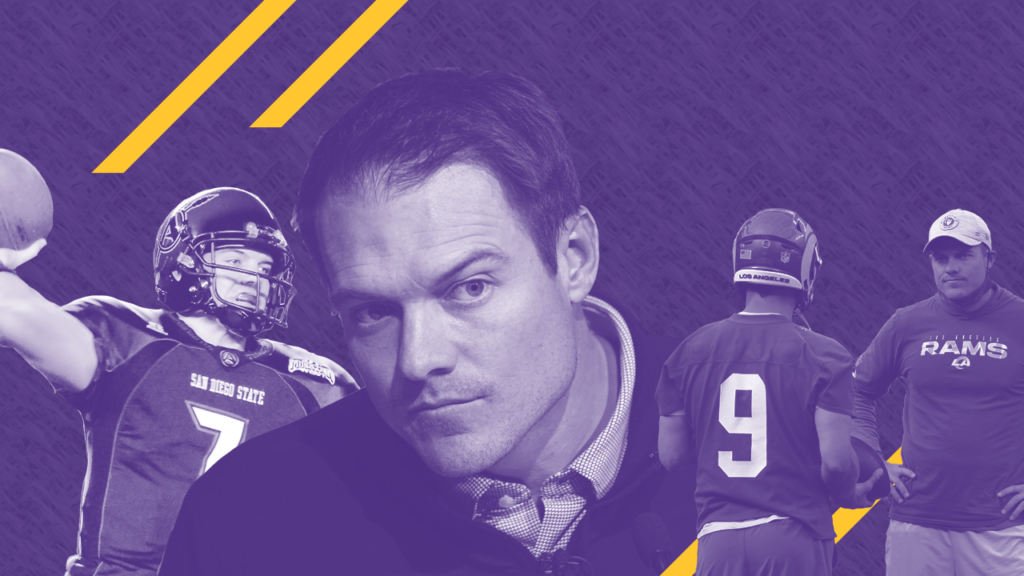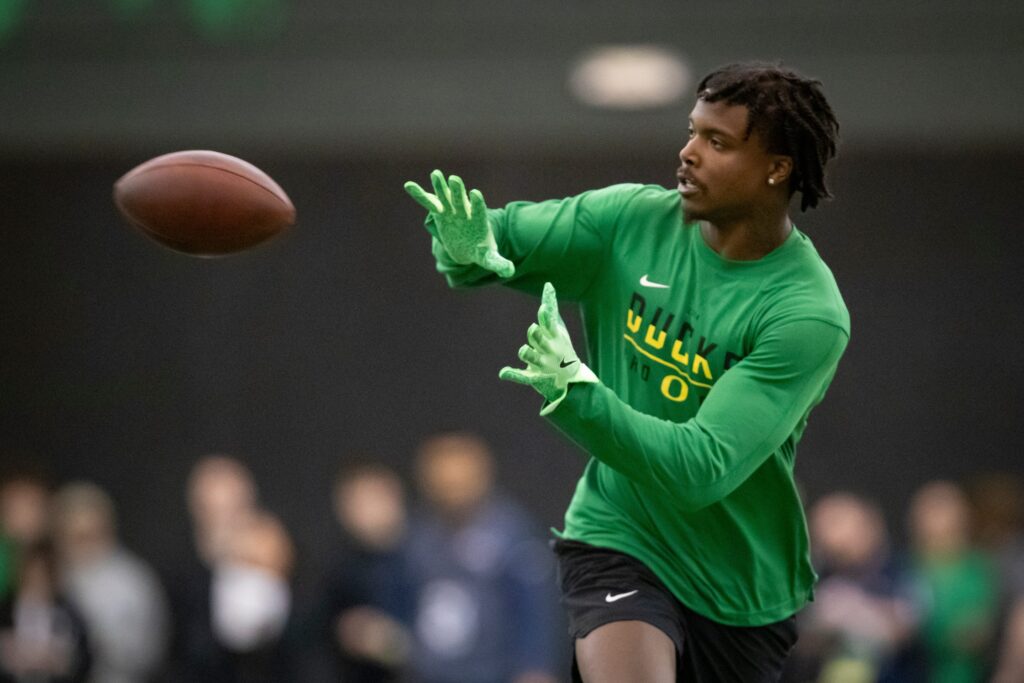Any grade-school teacher will tell you that they can figure out from an early age what many kids are going to be when they grow up. That’s how it is with football players eventually turning toward coaching. People around them see the coaching gene well before their playing days are over. That was very much the case with Minnesota Vikings head coach Kevin O’Connell.
“A lot of times you get the nudge from the coaches you do have, ‘Hey, have you thought about coaching?’” O’Connell said during his NFL Combine press conference.
The newest Vikings leader was a third-round pick of the New England Patriots in 2008. They liked his arm strength, size and 4.61 40-yard dash at the NFL Combine. But O’Connell will be the first one to admit that he wasn’t accurate enough to have a career as a starter at the highest level, despite impressive hand size. He saw a couple snaps in ‘08 with the Patriots and then was cut prior to the ‘09 season. And then he bounced around from the Lions to the Jets to the Dolphins and then back to the Jets and eventually finished his career in 2012 with six total NFL pass attempts.
O’Connell started coaching three years later. His first experience came on a 3-13 Cleveland Browns team where he served as the quarterbacks coach. The Browns’ struggles weren’t ideal but O’Connell got an opportunity to work with one of the NFL’s longest-tenured journeyman quarterbacks Josh McCown. That experience helped fortify his belief in the coaching path.
“I remember having a great connection and him giving me some great words of encouragement early on gave me the confidence to feel like I could potentially grow into a good coach,” O’Connell said.
During his NFL stops, O’Connell shared roster spots with Joe Thomas, Calvin Johnson, Darrelle Revis, Phillip Rivers and numerous other Pro Bowlers. The experience of seeing the ways in which the NFL’s best players operate up close helped shape his coaching philosophy.
“Great players I was around as a player, you take a lot from that and it leads you to believe you can have an impact helping players be the best possible versions of themselves and give them a chance to have success,” O’Connell said. “That’s what coaching in this league is… That’s what I love about it the most.”
Now in Minnesota, O’Connell’s task is to help quarterback Kirk Cousins, who signed a contract extension through 2023, be the best version of himself. Cousins and former head coach Mike Zimmer worked in the same building but didn’t sit down to watch tape together until 2021 — and even then, they couldn’t publicly agree on how often they watched tape or what the goals were of the tape sessions. They disagreed on lots of things, actually.
O’Connell is here to change that. He’s also here to improve the environment within the organization, which was not pretty at the end of Zimmer’s tenure. Players grew frustrated with Zimmer’s hard-nosed style and people within the building wanted a front-facing person who might not be so gruff.
O’Connell’s job is to avoid having anyone say, “The grass isn’t always greener…”
As he prepares for the draft and the installation of his offense throughout the summer program, O’Connell will be learning the head coaching ropes for the first time. His previous experience as a player will be vital in grabbing the attention of the team and getting everyone pulling in the same direction from Day 1.
But how does that actually work?
In order to find out, Purple Insider talked with three Minnesota college coaches who were former quarterbacks in their playing days. They shared how playing quarterback shaped who they are as program leaders and offensive schemers…
Concordia University St. Paul head coach Shannon Currier, Augsburg head coach Derrin Lamker and Minnesota Duluth offensive coordinator Chase Vogler each spent the first stanza of their football lives playing quarterback before joining the coaching ranks. They each say it was invaluable to have experience playing QB before taking the reins as a coach.
Currier was a backup QB at Hamline University in the early 90s who grew up loving Brett Favre. Lamker was a star pocket quarterback in the late-90s at Augsburg, earning himself a spot in the university’s athletic Hall of Fame. He was more of a Neil O’Donnell fan, himself. And Vogler is the youngest of the three, finishing his playing career as a duel-threat QB for Duluth in 2012. He went 46-6 as a starter and became Duluth’s OC in 2019. He’s also a Favre guy, and enjoyed watching the likes of Daunte Culpepper and Steve Young growing up (and he came to appreciate Tom Brady later).
They are different ages, had different careers and took the step from playing QB to coaching for different reasons. Currier’s dad was a coach, so he always envisioned himself making that a career.
“I remember from seventh grade and we had to do a paper in home ec[onomics] class about what we were going to be,” Currier said over the phone. “I knew early on that I wanted to be a coach.”
Currier said that knowing all along that he wanted to coach influenced the way he thought while he was a player. Kevin O’Connell can relate to that.
“I think it helped me because I enjoyed watching video and I think as a quarterback, our quarterbacks will put more time into it and they’re more dedicated to learning,” Currier said. “That’s a stereotype but a lot of quarterbacks are students of the game and the demands of the position are much more than some of the other positions and they are often times responsible for teaching the receivers and directing traffic and where the route break needs to be and all that experience helped my development learning the game.”
After his playing career, Currier started out as a third grade teacher and assistant high school coach in California and then landed a graduate assistant job at Bemidji State in 1994 and worked his way up the chain to Crookston, Southwest Minnesota State and then Concordia. He spent five seasons at Truman State between ‘04-’08 before returning to Concordia in 2016. He’s gone 47-41 overall at Concordia and was 6-5 last season.
Lamker is in his second season as Augsburg’s head coach. He coached high school for 11 years at Osseo, where they won the state title in 2015, and then at Edina for three seasons. At the college level, he’s gotten to ramp up the playbook more.
“They understand that it’s still a game but it’s taken a lot more seriously and there’s a lot more X’s and O’s and a lot more things that go into it, I’ve really enjoyed that part of it,” Lamker said.
The former Auggies standout didn’t exactly get into coaching for the playbooks though. He liked looking into the eyes of players knowing they were looking to him for leadership.
“That’s something that I really transferred over was looking in the huddle at all 10 guys or when you get to the sidelines all 100 guys are looking at you and your body reactions and how you react to certain situations,” Lamker said. “Everybody is great when things are going well. What are you going to do — what is coach O’Connell going to do for the Vikes — when he’s down 28-0?… I think that was a big advantage for me as a quarterback, knowing those things but also being able to get guys to follow.”
Lamker also loved the meetings and working together with coaches to find the answers.
That’s what really attracted Vogler to coaching, too. Whether you’re a quarterback or a coach, everything in football is a puzzle. He always loved trying to solve football and decided midway through his career that he wouldn’t rather do anything else.
“Watching film as a quarterback you start learning all that stuff and then you find out how fun and creative it can be and it turns into being interested in the coaching world and it goes from there,” Vogler said. “I knew when I was a sophomore in college after about a year and a half of playing at the collegiate level that I wanted to get into coaching. I set my schedule after that in college knowing that’s what I was going to do and glad that I did it.”
Vogler’s offense at Duluth averaged 34 points and 400-plus yards per game last year, ranking among the best in the conference. He’s found that being an offensive coordinator is similar to playing quarterback because you get all the praise when it works and all the criticism when it doesn’t work. There’s also the cat-and-mouse game of each week, doing everything to read and react to the opponent’s reads and reactions.
“The first head coach I worked under always talked about it as a game of chess,” Vogler said. “I think that’s something that’s really I’ve learned more and more as you get older and more experienced how that is really the game within the game and how to approach that.”
While Currier, Lamker and Vogler have different things that drew them to coaching, they see a lot of things the same way because of their experiences under center. For starters, their entire approach revolves around making their quarterback comfortable.
“It’s more the emotional element,” Currier said. “Some coaches get juiced up at the quarterback and I think I learned early on, how would I like to be as a player, how would I like to be responded to or coached? I think that’s important to help these quarterbacks move onto the next play.”
Currier referenced a story about Russell Wilson overcoming four interceptions to beat the Packers in a 2014 playoff game. Following the game, Wilson said that he’d put his entire focus on the next situation rather than getting bogged down by his miscues. Now Currier tries to implement that with his quarterbacks.
“It’s more than the X’s and O’s, it’s the interactions, the communication, the support, the encouragement,” Currier said. “Dealing with kids emotionally [has] really been enhanced from my quarterback experience.”
Lamker said that there’s value in simply understanding the challenges that a QB has to deal with on the field.
“A lot of times a lot of people are yelling, a lot of armchair quarterbacks from the sideline, ‘Why did you leave the pocket?’” Lamker said. “Well, when he comes to the sideline, I’m going to understand, well, because a 300-pounder got cut free and I wasn’t about to have him eat my lunch. I’ll be able to see those things…I’ll know that it was a smart decision.”
All three QB-turned-coaches emphasized making sure their quarterbacks were comfortable with the scheme and the plays they were going to be asked to run on Saturdays. Vogler meets with his quarterback on Thursdays and has him highlight and cross out plays that he likes or doesn’t like. He also gives his QB freedom to change things at the line of scrimmage.
“I always appreciated that when I was getting coached as a quarterback is, ‘Hey if you don’t like something, you have the freedom to check out of it,’ because I don’t want you to run something that you don’t like,” Vogler said. “You only get 65-75 plays in a game, we don’t want to waste one of them. I know that sounds like a big number but in the scheme of a game it really isn’t. For us it’s just me understanding that our quarterback has got to be the most comfortable on the field and also the smartest and the most knowledgeable.”
Some coaches would prefer their quarterback follow the scheme as it’s drawn up but these former QBs are aware that it doesn’t work that way. They want things to be more dynamic and sometimes the kid with the ball in his hands has perspective that his ex-QB coach does not.
“You have to be able to swallow your pride as a coach and have humility and not let your ego get bent out of shape if your player has good ideas too,” Currier said. “I think that’s important from the development as a coach, being comfortable with somebody else having the answers.”
Currier continued…
“I learned that I may like a play and it may look good on the board but when kids believe in a play, it’s more powerful. They can will the play to be successful even if it isn’t as good of a play from a structural standpoint. Because of their confidence in it, they find a way to get the ball in the window, even though the window might be tight. We value that element.”
Every coach will say that they want to play to their quarterback’s strength but there’s a difference between saying and doing it. Lamker said that evaluating and identifying a QB’s strengths is made easier because of his well-trained eye. He gave the example of calling different types of plays for QBs with different skill sets in the biggest spots of a game.
“Maybe it’s a deep drop or he’s got an extra strong arm to throw a little bit deeper so we can get a receiver down field farther or maybe he’s great rolling to his left and you have to design a few more plays for that in crunch situations,” Lamker said.
Each of our former QBs said they cared deeply about the mental makeup of a quarterback and had certain indicators that pointed to a quarterback being able to take his team the extra mile.
“We like athletes, we like big arms and we like winners,” Currier said. “We got a kid from Wisconsin this year and in three playoff games he brought his team from behind and that’s a trait that sold me that this kid is a winner.”
O’Connell is tasked with with applying all of these QB-turned-coach superpowers to the Vikings in the coming years. He’ll need to communicate with Cousins and create as much comfort for him as he can. He’ll need to play to Cousins’ strengths. He’ll need to evaluate Cousins and play a huge role in deciding whether he’s the quarterback of the future.
And he’ll need to grow as a head coach. Currier, Lamker and Vogler agreed that their playing experience laid the foundation for becoming successful coaches but they spent the subsequent years building on that rather than relying on it.
“When you’re a player you don’t understand the time commitment the coaches make,” Vogler said. “It’s awesome.”









